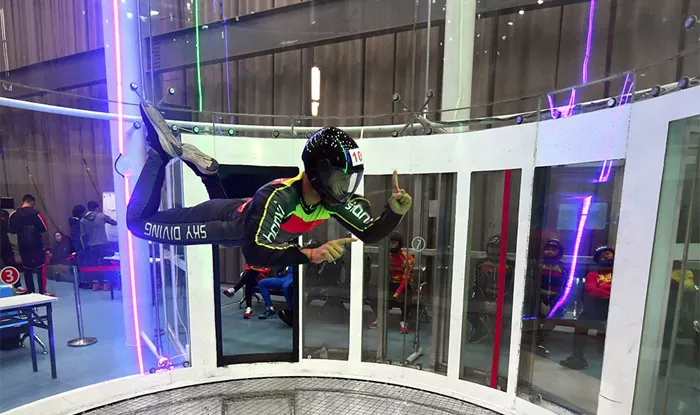Indoor skydiving has revolutionized the world of extreme sports, offering a thrilling experience in a controlled environment. This article delves deep into the intricate mechanics behind this exhilarating activity, shedding light on the advanced technology and scientific principles that make indoor skydiving possible.
What is Indoor Skydiving?
Indoor skydiving, also known as vertical wind tunnel flying, simulates the freefall experience of outdoor skydiving without the need to jump from an aircraft. Participants enter a vertical wind tunnel—a cylindrical chamber equipped with powerful fans that generate a vertical column of air. This airflow allows flyers to float effortlessly, experiencing the sensation of skydiving under safe and controlled conditions.
The Vertical Wind Tunnel
Understanding the Structure
The vertical wind tunnel is a marvel of engineering designed to replicate the conditions of freefall. Typically constructed from high-strength materials like reinforced concrete or steel, its cylindrical shape minimizes turbulence and ensures a smooth airflow path. The chamber features specialized diffusers and intake vents strategically placed to optimize the airflow dynamics within the flight area.
Airflow Dynamics
Airflow within the tunnel is carefully controlled to provide a stable and predictable environment for flyers. High-powered fans located at the base of the tunnel draw air through intake vents, accelerating it upwards through the flight chamber. This upward flow, combined with the tunnel’s design and diffusers, creates a laminar airflow—a smooth, uniform stream of air that allows flyers to maintain stable flight positions.
Flight Chamber Technology
Fan Systems
The heart of any vertical wind tunnel is its fan system. These fans are meticulously engineered to generate sufficient vertical lift to support flyers of varying weights and skill levels. Typically, large axial fans or multiple smaller fans are used to create the necessary airflow velocity, which can reach speeds of up to 160 miles per hour (260 kilometers per hour) in the flight chamber.
Control Mechanisms
Maintaining precise control over airflow is essential for ensuring flyer safety and comfort. Modern tunnels are equipped with sophisticated control systems that regulate fan speed and airflow direction in real-time. Variable frequency drives adjust fan RPMs to fine-tune airflow, while adjustable diffusers and airflow straighteners help maintain a consistent wind speed and minimize turbulence.
Safety Measures
Training and Instruction
Before entering the flight chamber, participants undergo comprehensive training led by experienced instructors. Training sessions cover basic body flight techniques, safety procedures, and communication signals used during flights. Instructors ensure that flyers understand how to enter and exit the chamber safely and how to maintain stable flight positions.
Protective Gear
Flyers wear specialized equipment designed to enhance safety and comfort during flights. This typically includes a jumpsuit made from durable yet flexible materials that reduce friction with the airflow. Helmets protect participants’ heads and provide mounting points for communication devices and cameras used to capture their flight experiences.
see also:Mastering Mountain Biking: Overcoming Challenges For Beginners
Experiencing Indoor Skydiving
Pre-Flight Preparation
Participants receive a thorough briefing before their flight, covering equipment usage, safety protocols, and flight techniques. Instructors explain the importance of body positioning and hand signals used for communication during flight. Flyers practice these techniques in a pre-flight training area to familiarize themselves with the sensation of floating in the wind tunnel.
Flight Techniques
Once inside the flight chamber, flyers apply their training to control their body positions and movements. Beginners learn to maintain a stable belly-down position, adjusting their arms and legs to ascend, descend, or rotate within the airflow. Advanced flyers progress to more complex maneuvers such as turns, flips, and even formations with multiple participants, showcasing their skill and agility.
Advanced Skills
Experienced flyers continually refine their techniques to master advanced maneuvers. These may include dynamic flying techniques that involve rapid changes in body orientation and airflow dynamics. Competition-level flyers push the boundaries with intricate aerial routines and precision formations, demonstrating the artistry and athleticism of indoor skydiving.
The Future of Indoor Skydiving
Technological Advancements
Ongoing research and development in indoor skydiving technology promise exciting advancements. Innovations such as augmented reality interfaces and enhanced airflow control systems aim to enhance the immersive experience for participants. These technologies could enable new training methods and interactive challenges that further blur the line between virtual and real-world skydiving.
Accessibility and Popularity
Indoor skydiving facilities continue to expand globally, making this exhilarating sport more accessible to enthusiasts of all ages and abilities. The sport’s popularity is fueled by its appeal as a thrilling recreational activity and a training tool for outdoor skydiving. Demographic trends show increasing participation among families, corporate groups, and competitive athletes seeking a safe and thrilling adventure.
Conclusion
Indoor skydiving combines adrenaline-pumping excitement with technical precision, offering enthusiasts a unique way to experience the thrill of flight. As technology continues to evolve, so too will the possibilities for this exhilarating sport. Whether you’re a first-time flyer or an experienced enthusiast, indoor skydiving promises an unforgettable journey into the world of controlled freefall.
Related topics:
- Exploring The Causes Of Skydiving Fatalities: Understanding Risks And Prevention Strategies
- Surfing: The Ultimate Full-Body Workout
- Skydiving: A Thrilling Adventure Or A Terrifying Plunge?

